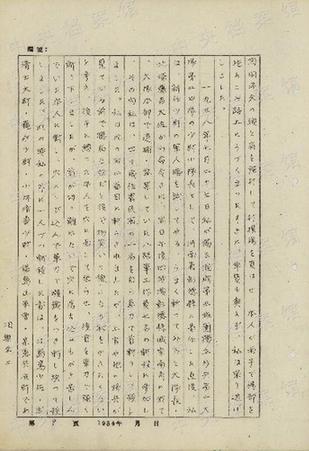据相乐圭二1954年11月笔供,他1916年出生在日本福岛县。1937年4月驻扎伪满洲国三江县。1938年7月起任步兵少尉小队长、中尉中队长、警备队长、代理大队长、大队长等职。日本投降后,投阎锡山部,任少将参谋长、团长等职。1949年4月被俘。

相乐圭二
重要罪行有:
1938年7月27日,奉大队长“要好好地斩杀”之命,参与对八路军俘虏的斩杀行动。“我就用军刀砍死了其中的40岁左右像个农民的人1名”。
1938年10月26日,由南宫县向新河县进攻之际,“我用军刀砍下了在凹地里隐藏的1名青年住民的手臂”。
1940年5月,在神池县,“射杀便衣民兵3名”,“在八角堡南门外枪杀了中队从大严备镇附近逮捕来的民兵2名”。
1940年7月,在朱家川一带抓捕了12名住民审问拷打,后“以刺刀刺杀了8名,射杀了4名”。另外,还“逮捕了行宫墕附近住民约70名左右,于行宫墕东边约1000米地方,把其中30余名用土埋其半身,以机关枪扫射,全部把他们杀害了”。另本部的和泉军医中尉和条田卫生军曹共同将1名八路军休养所中1名重病员“作为活人解剖手段把其杀害了”。
1940年9月,参加对八路军百团大战的反击作战,在任家村“第3中队长加藤友记逮捕了该村住民20名,于宁化堡把其全部射杀了”。
1941年9月下旬,指挥袭击王家沟,发出号令:“看到日军的住民而逃跑的都是敌性分子,赶快给我杀光!经射击的结果,射伤了住民7名”。“于东寨镇我纵容其拷问了住民10名,轮奸妇女5名”。
1941年8月—10月中旬期间,佐藤特务工作队“逮捕、并拷问了居民约40名,其中打死、射杀、刺杀20名”。
1942年2月,“扫荡马家河村,下令射杀住民3名”。“下令追击向西方逃避的住民,结果射杀住民3名、射伤3名”。
“我于1937年4月起至1945年9月3日止,参加日军对中国人民所犯下的罪恶事实,统计于下:即杀人总数为831名。杀人对象内计:男住民420名,女住民14名,民兵98名,八路军兵员252名,抗日军兵员38名,俘虏兵员9名”。杀人手段计:射杀、刺杀、斩首、烧死、摔死、饿死、瘐死(坐监狱而死)。
“伤害总人数为:519名”。手段是:射伤、砍伤、踩地雷炸伤、刺伤。
“强奸中国妇女人数合计为34名”。
“逮捕了住民的总人数为112名,此外在战场上俘虏兵员的人数为368名,这些人送往后方后的处理情况不明。尚有逮捕、抓捕的经过拷问和殴打审问的人数为住民215名。此外抓捕和平住民作为踩地雷、领路、当马夫、担挑行李、以及无代价奴役其修筑军用汽(车)路和筑城工事的人数有1171名”。
“对八路军在战场上使用过毒瓦斯(赤筒12个)一次一件”。

相乐圭二笔供原文
Abstract of the Written Confessions in English
Keiji Saganaka
According to the written confession of Keiji Saganaka in November 1954, he was born in Fukushima Prefecture, Japan in 1916. He was stationed in Sanjiang County of the “Manchukuo” in April 1937. After July 1938, he successively served as second lieutenant and infantry platoon leader, lieutenant and company commander, police captain, acting battalion commander and battalion commander. After Japan"s surrender, he served in Yan Xishan"s troops as major general and chief of staff, and regiment commander, etc. He was arrested in April 1949.
Major offences:
27 July 1938: following the order of the battalion commander of “kill well with saber”, took part in the killing of captives from the Eighth Route Army. “I killed a peasant-like person aged around 40 with saber”;
26 October 1938: when making attacks from Nangong County to Xinhe County, “I cut off with saber one arm of a young local resident who was hiding in a hollow”;
May 1940: in Shenchi County, “shot dead three militiamen in plain clothes”, “shot dead outside the south gate of Bajiaobao two militiamen, who were captured by the Company in a place near Dayanbei Township,”;
July 1940: captured 12 local inhabitants from areas around Zhujiachuan and interrogated them with torture, and then “stabbed 8 of them to death and shot dead the other 4”; in addition, also “captured about 70 inhabitants in areas around Xinggongyan, buried 30 of them waist-high, and shot them dead with machine guns in a place about 1,000 meters to the east of Xinggongyan”; Surgeon Lieutenant Izumi and Health Sergeant Jyoda of the Headquarters also jointly “killed through vivisection” a severely sick soldier in the sanatorium of the Eighth Route Army;
September 1940: while fighting with the Eighth Route Army in the counter-attack of the Great Campaign with One Hundred Regiments in Renjia Village, “Commander Kato Yuki of the Third Company captured 20 local villagers and shot all of them dead in Ninghuabao”;
Late September 1941: while commanding the attack on Wangjiagou, ordered that “Any inhabitant who tries to flee the Japanese army is an enemy. Kill them all! The result of shooting was injuring 7 inhabitants”; “In Dongzhai Township, I indulged them with torturing 10 inhabitants and gang-raping 5 women”;
From August to mid-October 1941: the Sato Agent Team “captured and tortured about 40 residents and 20 of them were beaten, shot or stabbed to death”;
February 1942: “mopped up Majiahe Village, ordered the shooting of 3 local inhabitants”; “ordered the pursuit and attack on escaping inhabitants, killing 3 and wounding another 3 inhabitants”;
“From April 1937 to 3 September 1945, a summary of my crimes in the Japanese army committed against the Chinese people: killing a total of 831 people, including 420 male inhabitants, 14 female inhabitants, 98 militiamen, 252 soldiers of the Eighth Route Army, 38 anti-Japanese soldiers, and 9 captive soldiers.” Methods of killing: shooting, bayoneting, beheading, burning, smashing, starving and imprisoning;
“Wounded 519 people” through shooting, slashing, exploding (with landmines) and bayoneting”;
“Raped a total of 34 Chinese women”;
“Arrested a total of 112 inhabitants, and captured 368 soldiers on the battlefield, how these people were treated after being sent to the rear is not clear; also 215 inhabitants were tortured during the interrogation after their arrest or capture; in addition, 1,171 civilians were captured and forced to step on landmines, lead the way, keep the horses, carry luggage, and work for free in the construction of motorways for military use and city fortifications”;
“Used poison gas (a dozen red colored canisters) against the Eighth Route Army once in the battlefield”.
(来源:国家档案局网站,编辑 Helen)
